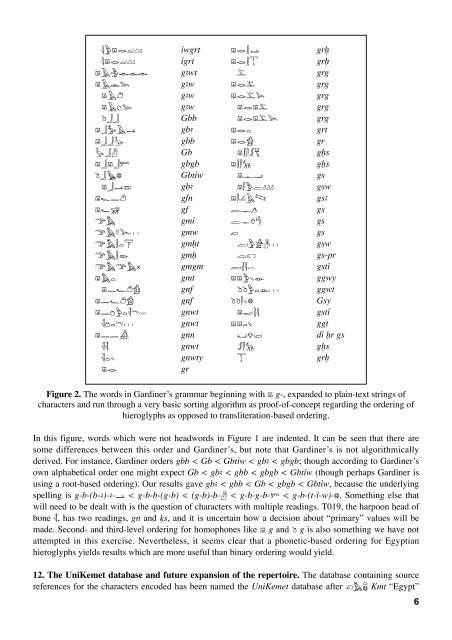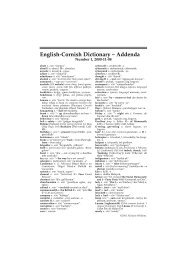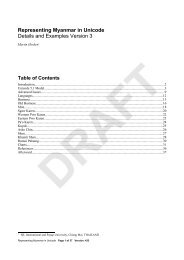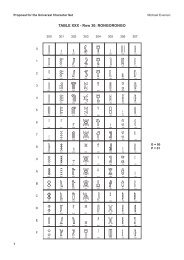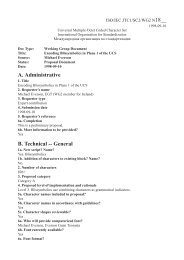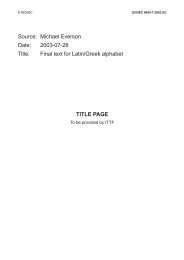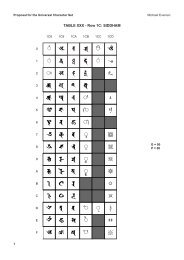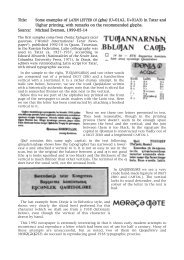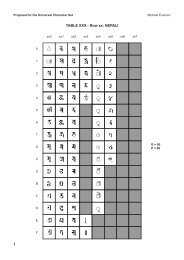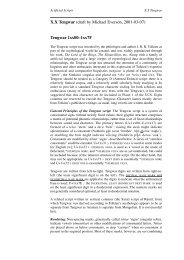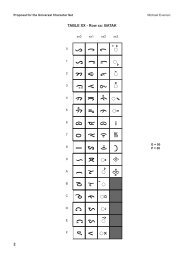Towards a Proposal to encode Egyptian Hieroglyphs in ... - Evertype
Towards a Proposal to encode Egyptian Hieroglyphs in ... - Evertype
Towards a Proposal to encode Egyptian Hieroglyphs in ... - Evertype
You also want an ePaper? Increase the reach of your titles
YUMPU automatically turns print PDFs into web optimized ePapers that Google loves.
≤ƃõ«µ ñwgrt<br />
≤ƒõ«µ ñgrt<br />
ƒ•Ø¬¬¬ g¨wt<br />
ƒ•¬´ g¨w<br />
ƒ•ö g¨w<br />
ƒ•Œ´ g¨w<br />
√†† Gbb<br />
ƒ†©•ù gb¨<br />
ƒ††¨ gbb<br />
≠†ï Gb<br />
ƒ†ƒ†ì gbgb<br />
√†∫ Gbtñw<br />
ƒ†ù¥… gb¨<br />
ƒ∞∑ö gfn<br />
ƒ∞¢ gf<br />
®ß gmñ<br />
®ßÃ~ gmw<br />
®ß¡«ª gmh. t<br />
®ß¡ô gmh.<br />
®ß®ßÕ gmgm<br />
ƒß« gmt<br />
ƒ∑∞öë gnf<br />
ƒ∑∞öë gnf<br />
ƒ∑∆Æ«Ω¿∂ gnwt<br />
Ω∆«¿~ gnwt<br />
ƒ∑∑í gnn<br />
ΩΩ gnwt<br />
Ω«À gnwty<br />
ƒõ gr<br />
ƒõ¡ù grh.<br />
ƒõ¡≥ grh.<br />
æ grg<br />
ƒõæ grg<br />
ƒõæ grg<br />
ěľ grg<br />
ěľ grg<br />
ƒõ« grt<br />
ƒõë gr<br />
ƒ¡ºü£ gh. s<br />
ƒ¡º° gh. s<br />
ƒ∏” gs<br />
ƒºÆœ»»» gsw<br />
ƒº“•π gs¨<br />
œ∏û gs<br />
ϸŔ gs<br />
—… gs<br />
œ…Æêñ~ gsw<br />
œ…‘ gs-pr<br />
œ…ø≤± gstñ<br />
ƒƒÆÀô ggwy<br />
√√Æ«ò~ ggwt<br />
√√ºÀ∫ Gsy<br />
ƒ–ø≤ gstñ<br />
ƒƒ«§ ggt<br />
úó…—… dñ h. r gs<br />
üº° gh. s<br />
≥ grh.<br />
Figure 2. The words <strong>in</strong> Gard<strong>in</strong>er’s grammar beg<strong>in</strong>n<strong>in</strong>g with ƒ g-, expanded <strong>to</strong> pla<strong>in</strong>-text str<strong>in</strong>gs of<br />
characters and run through a very basic sort<strong>in</strong>g algorithm as proof-of-concept regard<strong>in</strong>g the order<strong>in</strong>g of<br />
hieroglyphs as opposed <strong>to</strong> transliteration-based order<strong>in</strong>g.<br />
In this figure, words which were not headwords <strong>in</strong> Figure 1 are <strong>in</strong>dented. It can be seen that there are<br />
some differences between this order and Gard<strong>in</strong>er’s, but note that Gard<strong>in</strong>er’s is not algorithmically<br />
derived. For <strong>in</strong>stance, Gard<strong>in</strong>er orders gbb < Gb < Gbtñw < gb¨ < gbgb; though accord<strong>in</strong>g <strong>to</strong> Gard<strong>in</strong>er’s<br />
own alphabetical order one might expect Gb < gb¨ < gbb < gbgb < Gbtñw (though perhaps Gard<strong>in</strong>er is<br />
us<strong>in</strong>g a root-based order<strong>in</strong>g). Our results gave gb¨ < gbb < Gb < gbgb < Gbtñw, because the underly<strong>in</strong>g<br />
spell<strong>in</strong>g is g-b-(b-¨)-¨-ù < g-b-b-(g-b) < (g-b)-b-ï < g-b-g-b-ì < g-b-(t-ñ-w)-∫. Someth<strong>in</strong>g else that<br />
will need <strong>to</strong> be dealt with is the question of characters with multiple read<strong>in</strong>gs. T019, the harpoon head of<br />
bone Ω, has two read<strong>in</strong>gs, gn and k. s, and it is uncerta<strong>in</strong> how a decision about “primary” values will be<br />
made. Second- and third-level order<strong>in</strong>g for homophones like ƒ g and √ g is also someth<strong>in</strong>g we have not<br />
attempted <strong>in</strong> this exercise. Nevertheless, it seems clear that a phonetic-based order<strong>in</strong>g for <strong>Egyptian</strong><br />
hieroglyphs yields results which are more useful than b<strong>in</strong>ary order<strong>in</strong>g would yield.<br />
12. The UniKemet database and future expansion of the reper<strong>to</strong>ire. The database conta<strong>in</strong><strong>in</strong>g source<br />
references for the characters <strong>encode</strong>d has been named the UniKemet database after ø¿¡ Kmt “Egypt”<br />
6


